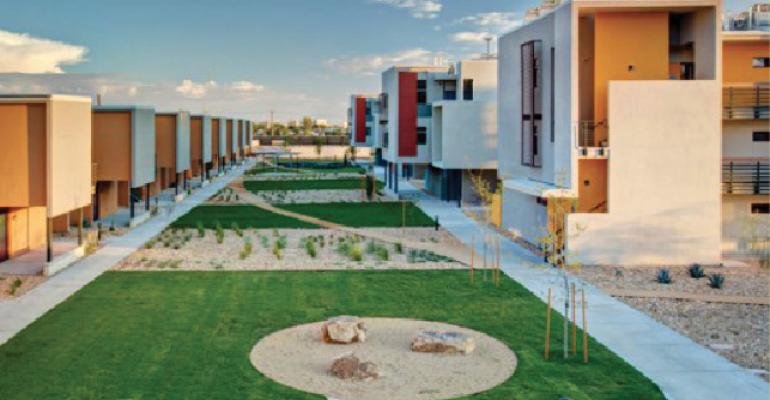Going green has never been easier in the seniors housing industry, with affordable properties leading the charge.
More companies supplying sustainable projects have emerged, setting costs lower for all of seniors housing, but the real catalyst for the industry has been the federal government getting behind the green movement. Many states require all new affordable projects, including seniors housing, to add some level of green features. As the expected wave of new retirees needing cheaper living will hit sometime in the next 10 years or so, the facilities to house them are getting smarter and cheaper to run—though there are still some concerns in the industry, experts say.
Colin Edelstein, director of Savannah, Ga.-based NorSouth Constructs, says that it is easier to add green features to affordable housing, including seniors housing, because of the way the projects are being financed. Affordable projects are usually built on the back of public funds or nonprofit institutions, so these civic-minded groups are more likely to support or even add funding when sustainable features are being implemented.
“In a market-rate project, it’s more challenging to do green features,” Edelstein says. “You have to keep the investor happy, and the more money you spend, the more equity they have to provide, and the narrower the yield.”
Conversely, affordable projects gain more tax credits the more money is spent, creating higher yield. Also, most of the state agencies that control the tax credits require green features before awarding the incentives. “The conventional world may have gotten a head start on analyzing how green features would best benefit a building, but the affordable world got a head start on adopting them,” Edelstein says.
The biggest new trend that Edelstein says he has noticed is the amount of new programs that have emerged in the past five to 10 years to grant official sustainable status, and how the cost of this certification has risen as the material costs have diminished. While the U.S. Green Building Council had led with its LEED rating system, other systems recently have also become popular, such as the Earthworks standard, developed for the Southeast in 1999 by the Greater Atlanta Home Builders Association and Southface.
“It has become costly to certify a building,” Edelstein says. “For a multifamily building, you can be looking at a five-digit number just to get a piece of paper that says you’re sustainable. It has gotten so a few companies will implement the green features, but may not go through certification.”
NorSouth Constructs recently won an award for sustainability for the Decatur Housing Authority’s Allen Wilson Terrace Public Housing Community in Decatur, Ga. The $30 million redevelopment project, including the construction of the 80-unit Oliver House, was named the EarthCraft Multifamily 2012 Project of the Year by Southface and the Greater Atlanta Home Builders Association. Some of the project’s features include a geothermal heat pump system to heat and cool common areas, a green roof that includes solar voltaic panels, a rainwater harvest system, low-flow plumbing fixtures and the use of low-VOCs paints.
Illinois is one of the states that requires affordable housing projects, including seniors housing, to include a certain amount of sustainability. Developers in the state must select a number of features from the Illinois Housing Development Authority’s 14-page “green checklist.” The features are assigned point values and the developer must select enough points to be certified and allowed to build. The checklist is pulled in part from the National Association of Home Builders Green Building program.
Laura Weyrauch, vice president of design and construction at Des Plaines, Ill.-based Pathway Senior Living LLC, said the checklists usually cause the developer to pick moderately-priced items, such as high-efficiency heating and cooling systems, that will have an immediate impact on monthly energy bills.
The developer can’t spend too much—operational costs at affordable properties have to be closely monitored and held in check, as the residents are not paying much in rent. “It’s really important to be smart in being energy efficient,” Wayrauch said. “[With] some of the more expensive green items, such as solar panels, the only way you can afford those is if someone is offering some type of energy grant. It’s just not as quick a return on investment,” she says.
While the commercial real estate industry has been enlightened enough to see the cost-benefit value in green features, Weyrauch said she’s not sure if the seniors housing sector, particularly affordable housing, has shown tremendous success. “It depends on who you ask,” Weyrauch says. “There’s the feeling that these features are good for a building, but sometimes it is rather hard to comply with the state checklist, as it is geared more toward single-family or market-rate multifamily homes. There is a whole cafeteria of items that don’t apply to seniors housing. In general, however, is the checklist has improved the attention paid to home items such as insulation and roof construction, and that benefits everyone.”
Minneapolis-based Ryan Cos. recently announced it is developing Thomas Place, an affordable seniors housing project in Orland Park, Ill. The $22 million, 80-unit property is on a four-acre site at the northeast corner of Wheeler Drive and Harlem Avenue.
The green features at Thomas Place include greater insulation in the walls and efficient heating, ventilation and air conditioning systems. The project is supposed to be open for residents by March 2013. The project is being financed under the Section 42 affordable housing program administered by the housing authority.
Michael Millar, a spokesman for Ryan, said it is somewhat difficult to juggle keeping costs low with achieving sustainability. “On the surface and in theory these are salient steps; however, it can increase costs by as much as 10 to 15 percent and take a number of years for the developer owner to recoup these expenses,” he explains. “In the long run, though, achieving various levels of increased energy efficiency makes a great deal of sense—and for the resident, helps ensure affordable housing is in fact affordable.”

